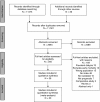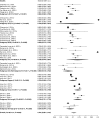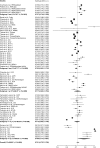Prediction of Risk of Death for Patients Starting Dialysis: A Systematic Review and Meta-Analysis
- PMID: 31362990
- PMCID: PMC6682819
- DOI: 10.2215/CJN.00050119
Prediction of Risk of Death for Patients Starting Dialysis: A Systematic Review and Meta-Analysis
Abstract
Background and objectives: Dialysis is a preference-sensitive decision where prognosis may play an important role. Although patients desire risk prediction, nephrologists are wary of sharing this information. We reviewed the performance of prognostic indices for patients starting dialysis to facilitate bedside translation.
Design, setting, participants, & measurements: Systematic review and meta-analysis following the PRISMA guidelines. We searched Ovid MEDLINE, Ovid Embase, Ovid Central Register of Controlled Trials, Ovid Cochrane Database of Systematic Reviews, and Scopus for eligible studies of patients starting dialysis published from inception to December 31, 2018.
Selection criteria: Articles describing validated prognostic indices predicting mortality at the start of dialysis. We excluded studies limited to prevalent dialysis patients, AKI and studies excluding mortality in the first 1-3 months. Two reviewers independently screened abstracts, performed full text assessment of inclusion criteria and extracted: study design, setting, population demographics, index performance and risk of bias. Pre-planned random effects meta-analysis was performed stratified by index and predictive window to reduce heterogeneity.
Results: Of 12,132 articles screened and 214 reviewed in full text, 36 studies were included describing 32 prognostic indices. Predictive windows ranged from 3 months to 10 years, cohort sizes from 46 to 52,796. Meta-analysis showed discrimination area under the curve (AUC) of 0.71 (95% confidence interval, 0.69 to 073) with high heterogeneity (I2=99.12). Meta-analysis by index showed highest AUC for The Obi, Ivory, and Charlson comorbidity index (CCI)=0.74, also CCI was the most commonly used (ten studies). Other commonly used indices were Kahn-Wright index (eight studies, AUC 0.68), Hemmelgarn modification of the CCI (six studies, AUC 0.66) and REIN index (five studies, AUC 0.69). Of the indices, ten have been validated externally, 16 internally and nine were pre-existing validated indices. Limitations include heterogeneity and exclusion of large cohort studies in prevalent patients.
Conclusions: Several well validated indices with good discrimination are available for predicting survival at dialysis start.
Keywords: Acute Kidney Injury; Area Under Curve; Bias; Cohort Studies; Comorbidity; Humans; Nephrologists; Patient Selection; Prevalence; Prognosis; Renal Dialysis; Risk; dialysis; mortality; mortality risk; peritoneal dialysis.
Copyright © 2019 by the American Society of Nephrology.
Figures




Comment in
-
Comorbidity and in-hospital mortality in peritoneal dialysis patients: data of the Emilia Romagna region of Italy.Eur Rev Med Pharmacol Sci. 2023 Jul;27(14):6867-6875. doi: 10.26355/eurrev_202307_33158. Eur Rev Med Pharmacol Sci. 2023. PMID: 37522699
Similar articles
-
Validation of prognostic indices for short term mortality in an incident dialysis population of older adults >75.PLoS One. 2021 Jan 20;16(1):e0244081. doi: 10.1371/journal.pone.0244081. eCollection 2021. PLoS One. 2021. PMID: 33471808 Free PMC article.
-
Beyond the black stump: rapid reviews of health research issues affecting regional, rural and remote Australia.Med J Aust. 2020 Dec;213 Suppl 11:S3-S32.e1. doi: 10.5694/mja2.50881. Med J Aust. 2020. PMID: 33314144
-
Postoperative mortality in patients on chronic dialysis following elective surgery: A systematic review and meta-analysis.PLoS One. 2020 Jun 26;15(6):e0234402. doi: 10.1371/journal.pone.0234402. eCollection 2020. PLoS One. 2020. PMID: 32589638 Free PMC article.
-
Psychosocial interventions for preventing and treating depression in dialysis patients.Cochrane Database Syst Rev. 2019 Dec 2;12(12):CD004542. doi: 10.1002/14651858.CD004542.pub3. Cochrane Database Syst Rev. 2019. PMID: 31789430 Free PMC article.
-
Predicting 1 year mortality in an outpatient haemodialysis population: a comparison of comorbidity instruments.Nephrol Dial Transplant. 2004 Feb;19(2):413-20. doi: 10.1093/ndt/gfg571. Nephrol Dial Transplant. 2004. PMID: 14736967
Cited by
-
Predicting mortality after start of long-term dialysis-International validation of one- and two-year prediction models.PLoS One. 2023 Feb 22;18(2):e0280831. doi: 10.1371/journal.pone.0280831. eCollection 2023. PLoS One. 2023. PMID: 36812268 Free PMC article.
-
Validation of prognostic indices for short term mortality in an incident dialysis population of older adults >75.PLoS One. 2021 Jan 20;16(1):e0244081. doi: 10.1371/journal.pone.0244081. eCollection 2021. PLoS One. 2021. PMID: 33471808 Free PMC article.
-
Physical Resilience Phenotype Trajectories in Incident Hemodialysis: Characterization and Mortality Risk Assessment.Kidney Int Rep. 2022 Jun 23;7(9):2006-2015. doi: 10.1016/j.ekir.2022.06.009. eCollection 2022 Sep. Kidney Int Rep. 2022. PMID: 36090502 Free PMC article.
-
Serum uric acid level and all-cause and cardiovascular mortality in peritoneal dialysis patients: A systematic review and dose-response meta-analysis of cohort studies.PLoS One. 2022 Feb 22;17(2):e0264340. doi: 10.1371/journal.pone.0264340. eCollection 2022. PLoS One. 2022. PMID: 35192651 Free PMC article.
-
Short-term and long-term survival in patients with prevalent haemodialysis-an integrated prognostic model: external validation.BMJ Support Palliat Care. 2024 May 17;14(2):222-229. doi: 10.1136/spcare-2022-003916. BMJ Support Palliat Care. 2024. PMID: 36596667 Free PMC article.
References
-
- Murtagh FEM, Addington-Hall J, Higginson IJ: The prevalence of symptoms in end-stage renal disease: A systematic review. Adv Chronic Kidney Dis 14: 82–99, 2007 - PubMed
Publication types
MeSH terms
Grants and funding
LinkOut - more resources
Full Text Sources
Medical

